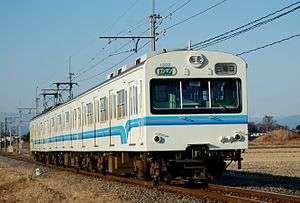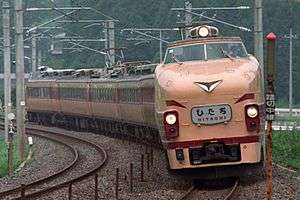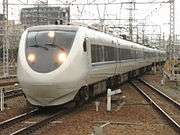101 series
| 101 series | |
|---|---|
 JR East 3-car Tsurumi Line set at Musashi-Shiraishi Station, circa December 1990 | |
| In service | 1957–2003 |
| Replaced | 72 series |
| Constructed | 1957–1969 |
| Entered service | December 1957 |
| Scrapped | 1987–2014 |
| Number built | 1,535 vehicles |
| Number in service | None |
| Number preserved | 1 vehicle |
| Formation | 2, 3, 6, 7, 8 or 10 cars per trainset |
| Operator(s) |
JNR (1957–1987) JR East (1987–2003) JR-West (1987–1992) Chichibu Railway (1986–2014) |
| Specifications | |
| Car body construction | Steel |
| Car length | 20,000 mm (65 ft 7 in) |
| Width | 2,879 mm (9 ft 5.3 in) |
| Doors | 4 pairs per side |
| Maximum speed | 100 km/h (62 mph) |
| Traction system | Resistor control |
| Acceleration |
2.0 km/h/s (7-car formation) 3.2 km/h/s (all motored cars) |
| Deceleration |
3.0 km/h/s (service, 7-car set) 3.5 km/h/s (emergency) |
| Electric system(s) | 1,500 V DC |
| Current collection method | overhead catenary |
| Bogies | DT21, DT21T, TR64 |
| Track gauge | 1,067 mm (3 ft 6 in) |

The 101 series (101系 101-kei) was a DC electric multiple unit (EMU) commuter train type introduced in 1957 by Japanese National Railways (JNR), and formerly operated by East Japan Railway Company (JR East) and West Japan Railway Company (JR-West). The last remaining trains were withdrawn in November 2003.
History
The prototype 101 series set was delivered in June 1957, as a 10-car (4+6-car) set classified as 90 series with all cars motored. Cab cars were numbered MoHa 90500 to 90503, and the intermediate cars were numbered MoHa 90000 to 90005. Production sets were delivered from March 1958, differing visually from the prototype in having exposed rain gutters along the top of each car. The 90 series was reclassified as 101 series from 1959, with the prototype set cars numbered in the 900 subseries. The prototype set was modified in 1962 to bring it up to production set standards.[1]
Lines used
101 series trains operated on the following lines.
Tokyo Area
- Chūō Line (Rapid) (1957-1985)
- Itsukaichi Line (1978-1985)
- Keihin-Tohoku Line (1970-1978)
- Musashino Line (1973-1986)
- Nambu Line (1969-1991 for commuter rail services; 1980 - November 2003 for Branch line services)
- Chūō-Sōbu Line (1963-1988)
- Tsurumi Line (1980-1992)
- Yamanote Line (1961-1968)
Osaka Area
- Kansai Main Line
- Katamachi Line (1976-1992)
- Osaka Loop Line (1964-1991)
- Sakurajima Line (1961-1991)
Private operators
A number of former 101 series trains were sold to the private railway operator Chichibu Railway in Saitama Prefecture in 1986, where they operated as 3-car 1000 series sets until March 2014.
 A Chichibu Railway 1000 series set in January 2008
A Chichibu Railway 1000 series set in January 2008 Chichibu Railway 1000 series sets in "revival" JNR liveries in December 2007
Chichibu Railway 1000 series sets in "revival" JNR liveries in December 2007
Preserved examples

KuMoHa 101-902 is preserved at The Railway Museum in Saitama, previously preserved at JR East's Tokyo General Rolling Stock Center.[2]
References
- JR全車輛ハンドブック'93 [JR Rolling Stock Handbook 1993]. Japan: Neko Publishing. 1993.
- JR電車編成表 '98夏号 [JR EMU Formations - Summer 1998]. Japan: JRR. July 1998. ISBN 978-4-88283-029-0.
- ↑ プロトタイプの世界 - Prototype World. Japan: Kōtsū Shimbunsha. December 2005. OCLC 170056962.
- ↑ Railway Museum exhibit details Archived 6 March 2009 at the Wayback Machine.. Retrieved on 28 April 2009. (in Japanese)
External links
| Wikimedia Commons has media related to JNR 101. |
- "JR East 101 series". Archived from the original on 4 February 2004. Retrieved 2011-10-27. (in Japanese)

